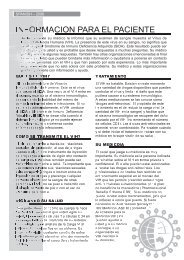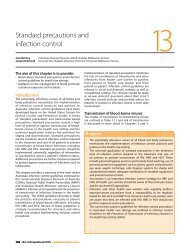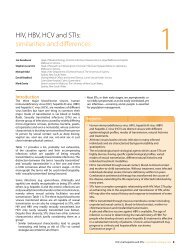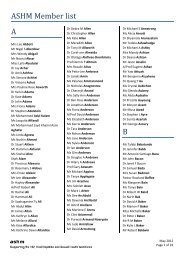B Positive – all you wanted to know about - ASHM
B Positive – all you wanted to know about - ASHM
B Positive – all you wanted to know about - ASHM
You also want an ePaper? Increase the reach of your titles
YUMPU automatically turns print PDFs into web optimized ePapers that Google loves.
a study assessing the long-term outcome of<br />
Hbsag positive individuals who had normal<br />
Lfts and normal or minimal changes on liver<br />
biopsy, the liver his<strong>to</strong>logy and aLt remained<br />
unchanged over a 12-year follow-up period.<br />
a sm<strong>all</strong> minority (2%) of these subjects<br />
developed HbV reactivation with aLt flares.<br />
in contrast <strong>to</strong> the subjects with normal aLt,<br />
subjects with evidence of active liver disease<br />
(high aLt or inflammation on liver biopsy) had<br />
a worse prognosis, with an annual risk rate of<br />
developing cirrhosis and Hcc of 1% and 0.5%,<br />
respectively. 6 However, 10<strong>–</strong>20% of subjects<br />
in the immune control phase may have<br />
subsequent reactivation of HbV with immune<br />
escape, even after many years. 7<br />
Table 4.4. Fac<strong>to</strong>rs influencing chronic hepatitis B progression <strong>to</strong> cirrhosis and<br />
hepa<strong>to</strong>cellular carcinoma<br />
Host fac<strong>to</strong>rs Viral fac<strong>to</strong>rs Other fac<strong>to</strong>rs<br />
Older age High HBV DNA level Alcohol consumption<br />
Male Genotype C 14 Co-infection with hepatitis<br />
4. Immune escape phase (HBeAgnegative<br />
chronic hepatitis B)<br />
this phase is characterised by negative Hbeag,<br />
positive anti-Hbe and detectable viral load<br />
(HbV dna > 2000 iu/mL). it is often termed<br />
precore mutant HbV because a mutation in<br />
the precore region of the dna results in a lack<br />
of Hbeag production. Patients can reach this<br />
phase from the immune control state (5<strong>–</strong>10%), 8<br />
or can progress directly from Hbeag-positive<br />
chronic hepatitis <strong>to</strong> Hbeag-negative chronic<br />
hepatitis (10-30%) 6 C, human<br />
immunodeficiency virus<br />
(HIV), hepatitis D<br />
(figure 4.1).<br />
Obesity, diabetes 15<br />
Figure 4.1 The four phases of hepatitis B infection<br />
10-30%<br />
Immune <strong>to</strong>leranance phase<br />
Immune clearance phase<br />
Immune control phase<br />
Immune escape phase<br />
10-20%<br />
figure 4.1: the four phases of hepatitis b infection<br />
Hbeag-negative chronic HbV infection is<br />
reported in <strong>all</strong> parts of the world, but is more<br />
common in asian and Mediterranean countries.<br />
it occurs due <strong>to</strong> the selection of a mutant HbV,<br />
which does not produce Hbeag but is still able<br />
<strong>to</strong> replicate. this immune selection process<br />
is likely <strong>to</strong> occur late in the natural his<strong>to</strong>ry of<br />
chronic HbV infection.<br />
thus, patients who are Hbeag negative tend<br />
<strong>to</strong> be older and have more advanced liver<br />
disease. the natural course of patients with<br />
Hbeag-negative disease is characterised by<br />
fluctuations in clinical status, and biochemical<br />
and viral load parameters caused by recurrent<br />
hepatic flares. although patients with Hbeagnegative<br />
disease tend <strong>to</strong> have lower HbV viral<br />
load than those with Hbeag-positive infection<br />
(< 20,000 iu/mL vs > 20,000 iu/mL), they<br />
display more hepatic inflammation on liver<br />
biopsy. 9 consequently, the annual incidence<br />
of cirrhosis is significantly higher (8<strong>–</strong>10%) in<br />
Hbeag-negative chronic hepatitis b patients,<br />
compared <strong>to</strong> that in Hbeag-positive patients<br />
(2<strong>–</strong>6%). 10<br />
Reactivation of HBV following<br />
immunosuppression<br />
in the context of immunosuppression,<br />
subjects in the immune control phase of cHb<br />
may experience a reactivation of the disease.<br />
reactivation can occur in subjects who are<br />
Hbsag positive, and even in those who are<br />
Hbsag negative/anti-Hbc igG positive (occult<br />
HbV). the reactivation is characterised by<br />
positive anti-Hbc igM but at lower titre than<br />
acute infection. it has been reported in 20<strong>–</strong>50%<br />
of those with hepatitis b infection undergoing<br />
immunosuppressive treatment, and may result<br />
in fulminant hepatic failure. 11 it is important<br />
for people with HbV infection undergoing<br />
immunosuppressive therapy <strong>to</strong> be carefully<br />
moni<strong>to</strong>red and managed appropriately with<br />
prophylaxis, as indicated (see chapter 10:<br />
Managing hepatitis b virus infection in complex<br />
situations).<br />
Occult HBV<br />
With the emergence of highly sensitive HbV<br />
dna Pcr assays, a population of patients have<br />
been identified with occult HbV infection. occult<br />
hepatitis b infection refers <strong>to</strong> the presence<br />
of the hepatitis b virus in the blood or liver<br />
without the detection of Hbsag. its presence<br />
may be related <strong>to</strong> the long-term persistence of<br />
HbV dna reservoir in hepa<strong>to</strong>cytes in the form<br />
of covalently-closed-circular dna (cccdna).<br />
the reactivation of hepatitis b following<br />
immunosuppression has been described<br />
b <strong>Positive</strong> <strong>–</strong> <strong>all</strong> <strong>you</strong> <strong>wanted</strong> <strong>to</strong> <strong>know</strong> <strong>about</strong> hepatitis b: a guide for primary care providers 43






